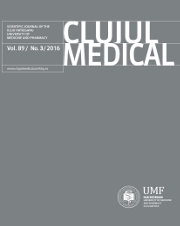Antibiotic treatment and resistance in chronic wounds of vascular origin
DOI:
https://doi.org/10.15386/cjmed-647Keywords:
vascular chronic wounds, antibiotic resistance, antibiotic treatmentAbstract
Background and aim. The problem of antibiotic resistance is worldwide and affects many types of pathogens. This phenomenon has been growing for decades and nowadays we are faced with a wide range of worrisome pathogens that are becoming resistant and many pathogens that may soon be untreatable. The aim of this study was to determine the resistance and antibiotic treatment in chronic wounds of vascular origin.
Methods. We performed a cross sectional study on a sample of patients with chronic vascular wounds, hospitalized between October 2014 and August 2015, in the Clinic of Vascular Surgery in Trakia Hospital Stara Zagora. The statistical analysis of data was descriptive, considering the p value of ≤0.05, the threshold of statistical significance.
Results. In the group of 110 patients, the significantly most frequent chronic wound (p<0.001) was peripheral arteriopathy (47.3%, CI95%: 38.19-56.54). Among 159 strains, 30% of patients having multiple etiology, the species most frequently isolated were Staphylococcus aureus, E.coli, Enterococcus faecalis, Pseudomonas aeruginosa and Proteus mirabilis with a significant predominance (p<0.05) of the Gram negative (55.1%). The spectrum of strains resistance included the Beta-lactams (36.4%, p<0.001), Macrolides (20%), Tetracyclines (9.1%), Aminoglycosides (8.2%) and Fluoroquinolones (4.5%).
Conclusions. Gram negative microorganisms were the main isolates in patients with vascular chronic wound. Significantly predominant was the resistance to the beta-lactam antibiotics.
Downloads
Published
How to Cite
Issue
Section
License
The authors are required to transfer the copyright of the published paper to the journal. This is done by agreeing to sign the Copyright Assignment Form. Whenever the case, authors are also required to send permissions to reproduce material (such as illustrations) from the copyright holder.

The papers published in the journal are licensed under a Creative Commons Attribution-NonCommercial-NoDerivatives 4.0 International License.

